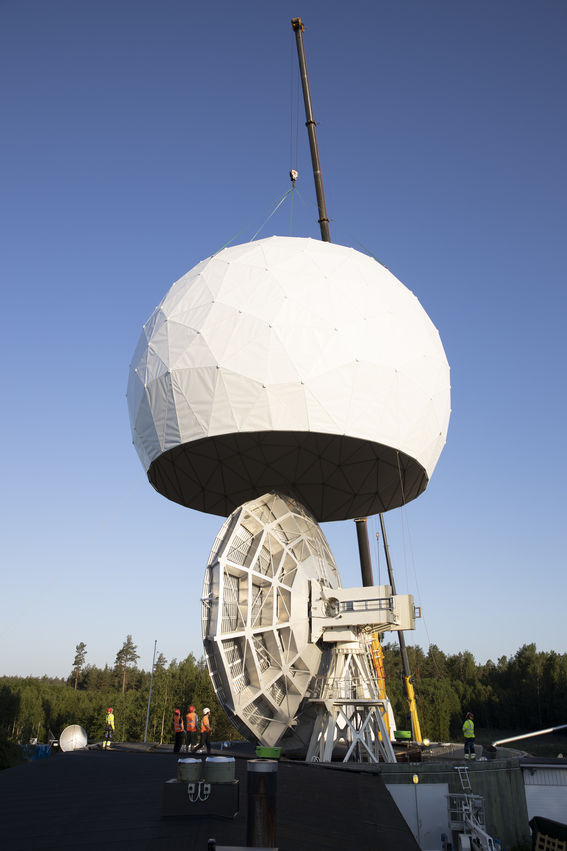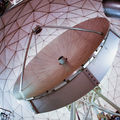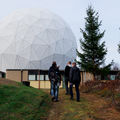Like a massive golf ball - Metsähovi Radio Observatory got a new radome

Finland's largest astronomical measuring device, the 14-metre radio telescope at Aalto University's Metsähovi Radio Observatory, got a new radome on 24 June. The painstaking work of switching the domes, was conducted in the early hours of the morning so that the wind would not interfere with moving the 20-metre radomes. The old radome had been in place for nearly thirty years.
The dome, which resembles a massive golf ball, is a landmark for Metsähovi, which is located in Kirkkonummi,, and a part of its main instrument of research. The radome protects the sensitive measuring devices against snow, wind, rain, and direct heat radiation from the sun, but lets radio waves pass through almost unimpeded, enabling the radio telescope to make observations inside the dome. Because of this, the telescope can be pointed at the sun, whose activities are monitored daily at Metsähovi year-round.
A new radome is not something that can simply be picked up from a store. There are only a few companies in the world that can manufacture a radome that suits the high radio frequencies used by Metsähovi.

The structure comprises 340 triangular aluminium frames with woven glass fabric covered with a protective material stretched between them. The triangles are not identical - their structure is uneven to ensure that the radome will cause as few disturbances as possible for the detection of radio signals. The structure weighs about eight tons.
Preparations for the operation took months, and about ten people worked for a couple of weeks on switching the domes and building the new one. A separate assembly area had to be built at Metsähovi to complete the project. Aalto University has granted funding worth nearly a million euros for replacing the protective radome.

Upgrading Finland's only radio research station
Metsähovi is Finland's only radio observatory, and its only astronomical observation station that is in constant use. It's key research areas are the activities of the sun, super-massive black holes, and very-long-baseline interferometry (VLBI), a method which allowed Metsähovi to be part of an international Event Horizon Telescope (EHT) collaboration in making the first image of a black hole.

Internationally Metsähovi is known for its unique uninterrupted observational data from the sun and distant black holes, over a period of more than 40 years. Thanks to its northerly location and long summer days, Metsähovi can monitor the sun for up to 14 hours at a time.
‘Solar research is important for predicting solar flares, which affect how electric networks and satellites work, and it also helps in understanding the activities of other stars’, says Metsähovi Director Joni Tammi.
The new radome makes it possible to continue to make observations for decades forward. An extensive renovation is now under way at Metsähovi, and Aalto University is also raising funds for the acquisition of a radio receiver with the newest technology available. With its help it could be possible to make observations on three different frequencies at a time.
‘Many national radio observatories have been shut down around the world, as funding focuses on major international projects. It is great that there are efforts in Finland to invest in the development of research infrastructure, as it allows us to conduct research that requires persevering and quick reactions’, Tammi says.
Further information:
Juha Kallunki
Laboratory engineer
[email protected]
Joni Tammi
Metsähovi Director
[email protected]
Read more
Metsähovi Radio Observatory
Metsähovi Radio Observatory is the only astronomical radio observatory in Finland. Metsähovi’s main instrument is the 14-metre radio telescope, which is used around the clock, every day of the year. Its observational data is used, e.g., for studying active galaxies, the Sun, and the rotation of the Earth.

Metsähovi Radio Observatory publishes solar data spanning more than four decades
The amount of data Metsähovi receives from the Sun is huge and is growing daily with new findings.

Renovations at Metsähovi Radio Observatory start in September
The observatory will see a total makeover in researcher and visitor facilities as well as in equipment.

Read more news
From coffee rooms to big crowds – Discussion is important in developing new lifewide learning content in Aalto
Craig Carlson is developing educational content for the target audience of lifewide learning, such as adult learners in working life.
Pengxin Wang: The internship was an adventure filled with incredible research, unforgettable experiences, and lifelong friendships.
Pengxin Wang’s AScI internship advanced AI research, fostered global friendships, and inspired his journey toward trustworthy AI solutions.Talent Boost Strategy Project at Aalto in 2021-2024
This article takes a look at the achievements of the Talent Boost project at Aalto.